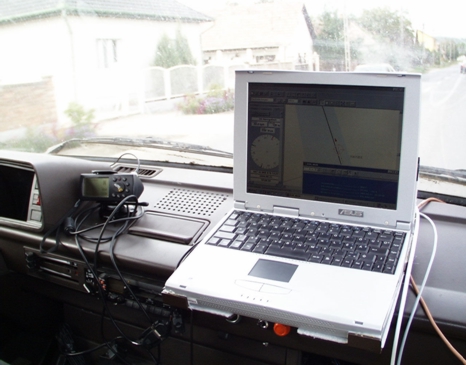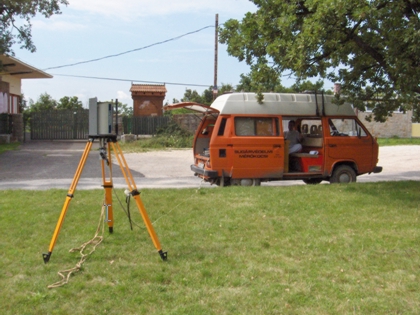Mobile Laboratory

GPS in the Mobile laboratory
In emergency situations the mobile laboratory is of
special importance. With a view to evaluating
radioactive contamination, this vehicle equipped
with an in situ gamma spectrometer, a thyroid
monitor, a survey meter, an air sampling unit, and a
GPS monitor.

The mobile laboratory measuring with the In-situ detector
DEVELOPMENTS OF THE MOBILE LABORATORY
Károly Bodor, István Szõke
Objective
The main task of the mobile laboratory is to locate and identify radioactive sources in case a radioactive material is lost or an emergency situation occurs. A new central environmental control system has been developed at the Environmental Protection Service (EPS). This new complex environmental control system was extended with a wireless internet connection between the main server and the main control system of the Mobile Laboratory. With this development the Mobile laboratory is traceable on the main screen of the EPS.
In 2010 the mobile laboratory participated the national intercomparison exercise near Püspökszilágy.
Methods
The previous assistant program of the BNS 98 dose rate meter provided by the vendor was incompatible with modern operating systems. For this reason a new version of the assistant program was requested from the vendor. The new main control system of the EPS has been extended in order to analyze and display the data provided by the BNS 98 dose rate meter of the mobile laboratory (Fig. 1. “Mozgó labor” window). The control system of the mobile laboratory was also extended with some applications. It collects the measured GPS and dose rate data into two respective files with a TeraTerm application. Another recently developed assistant programme reads the incoming data from the files and displays them in a special window called “ADAT SZOLGÁLTATÓ”. The combined and displayed data are transferred by another recently developed assistant programme to the main control system of the EPS with mobile internet connection.
During the intercomparison exercises the mobile laboratories used different in-situ gamma spectrometers to measure the actual background near Püspökszilágy. The measuring time was one hour. The measured spectras were evaluated with the GENIE 2000 software.
Results
The recently developed new computer code, which transmits GPS and BNS 98 dose rate data to the main server of the environment control system of the Mobile Laboratory, has been tested. The test revealed that the position of the Mobile Laboratory, which displayed on the main screen of the EPS, was incorrect. We measured the GPS coordinates of the KFKI campus more than five points. After the GPS measurements, the position program of the computer code was calibrated, and tested (Fig. 1.). Now the system works properly.
The measured and evaluated spectrums were compared, our results were similar with other results. The mobile laboratory of the EPS has a portable iodine measuring system only in Hungary. Some control measurements were taken with this measuring system during the intercomparison exercise.
Remaining work
The displayed meteorological data are significantly different from the real value. In the future these problem will be fixed.

